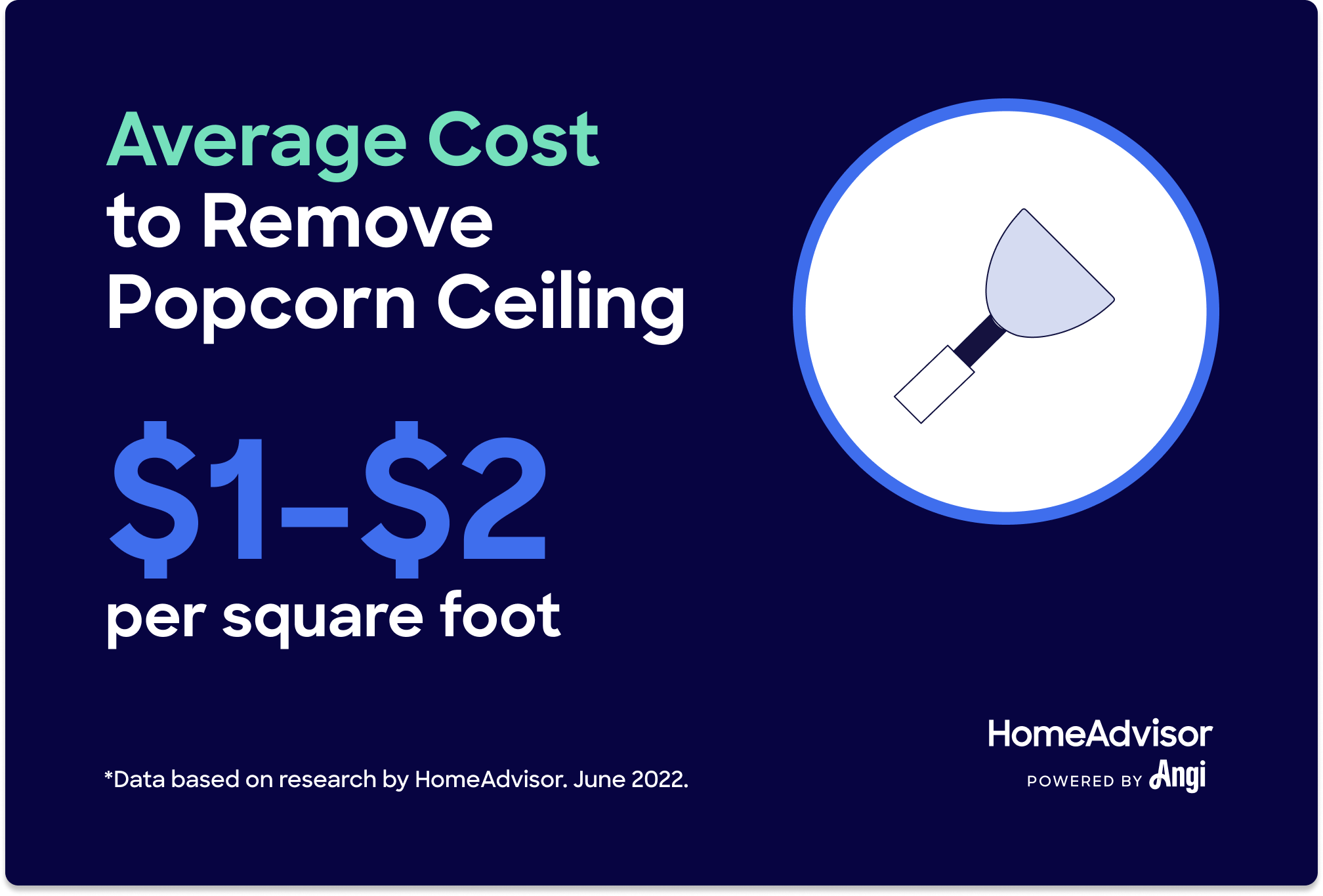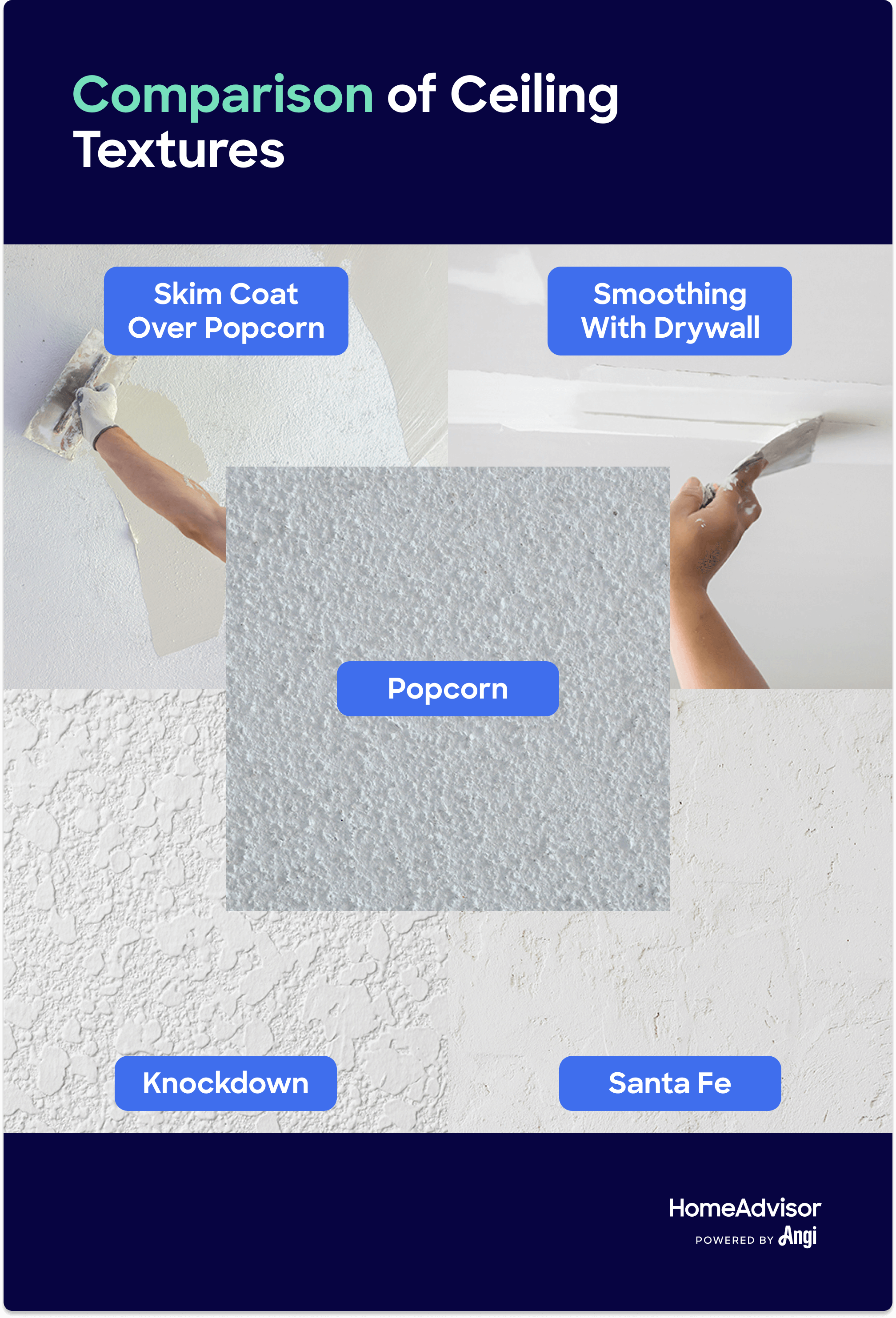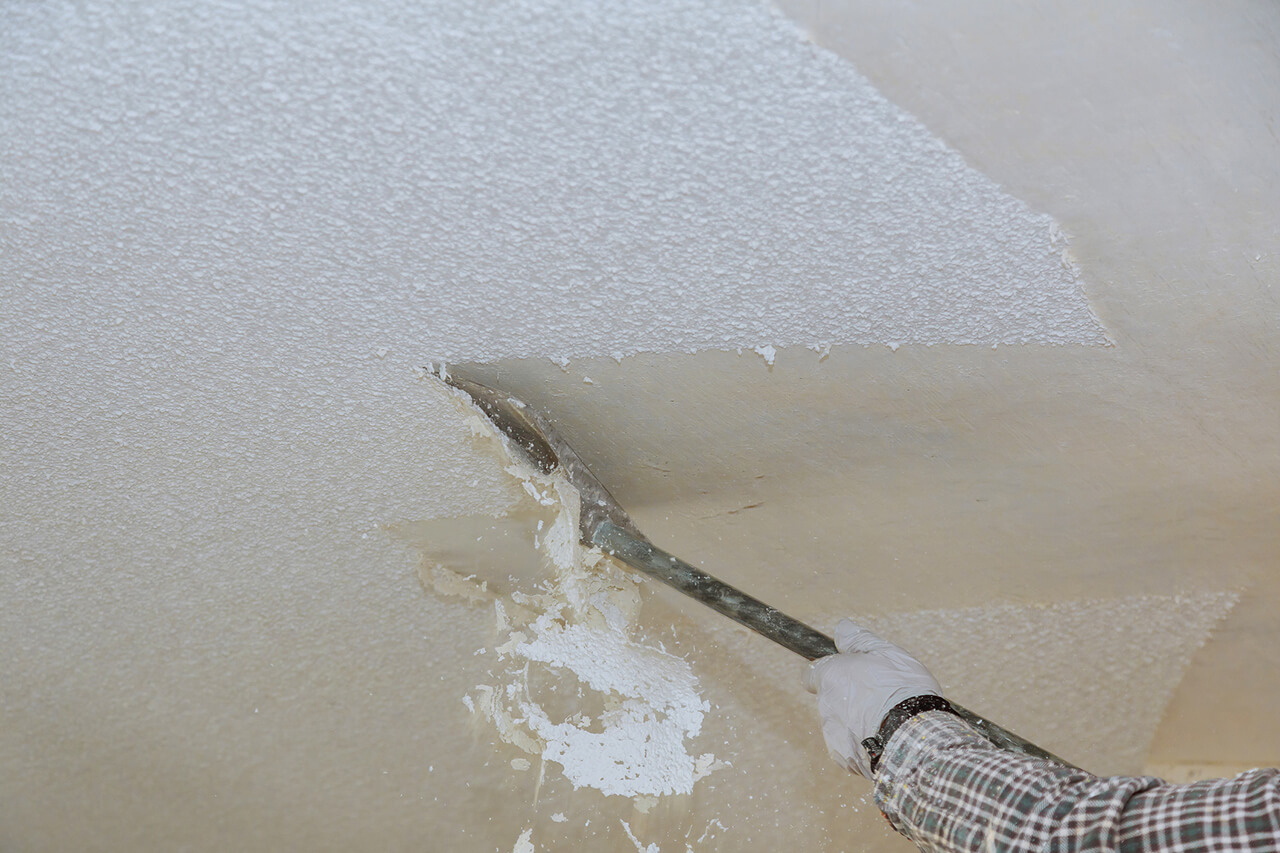How Much Does Popcorn Ceiling Removal Cost?
Typical Range:
$928 - $3,042
Typical Range:
$928 - $3,042
Cost data is based on actual project costs as reported by 3,935 HomeAdvisor members. Embed this data
.
.
.
.
.
.
.
.
.
.
.
.
.
.
.
.
.
.
.
.
.
.
.
.
.
.
.
.
.
.
•
•
•
•
Updated July 26, 2022
Reviewed by Robert Tschudi, Expert Home Building and Remodeling Contributor.On average, the price for removing a popcorn ceiling falls between $1 and $2 per square foot, with the average homeowner spending around $1,985. After considering labor and the room size, most homeowners spend between $928 and $3,042 on the project. Texture, painting, or other refinishing options like decorative tiles will add extra costs.
Once all the rage, the dated cottage-cheese look of a popcorn ceiling isn’t favored by modern standards. Luckily, getting rid of it is just a matter of scraping off the hard, textured layer—a straightforward (albeit tough and messy) process. However, factors like asbestos and structural issues may complicate the project. All of that considered, here’s what your budget could look like.
Let's calculate cost data for you. Where are you located?
Where are you located?
| National Average | $1,985 |
| Typical Range | $928 - $3,042 |
| Low End - High End | $300 - $5,700 |
Cost data is based on actual project costs as reported by 3,935 HomeAdvisor members.
A popcorn ceiling, sometimes called an acoustic ceiling, is a textured ceiling with a look and feel similar to its namesake snack. This spray-on surface was incredibly popular throughout much of the 20th century, but many current homeowners—and potential buyers—find the style unattractive and outdated.
Once a home trend, popcorn ceilings were a stylish coverup for anything unsightly on the ceiling, such as nail holes, screws, uneven seams, and water damage. The texture also made an excellent sound insulator, hence its second name, “acoustic ceiling.” Today, however, homeowners can invest in ceiling repair rather than dealing with the pitfalls of popcorn ceilings.
Twentieth-century homebuyers loved the practicality of popcorn ceilings. Today, people are far more focused on the cons of this finishing style:
Repairs are expensive and time-consuming
The rough texture traps dirt, dust, and cobwebs
Cleaning the crevices is extremely difficult
The look is dated and usually off-putting to buyers, potentially bringing down the home’s resale value
Asbestos is likely, so crumbling or damaged ceilings should be professionally removed ASAP
Labor, size, and finishing texture are your biggest cost factors for this project. The cost of removing an asbestos popcorn ceiling will carry much higher labor expenses. Below is a breakdown of what makes up your budget.
| Cost Consideration | Average Cost |
|---|---|
| Asbestos | $3 – $7 per square foot |
| Labor | $15 – $40 per hour |
| Area Size | $1 – $2 per square foot |
| Repainting | $1 – $3 per square foot |
When budgeting for this project, it’s a good idea to leave extra room for asbestos testing fees and possible removal, which will typically run anywhere from $3 to $7 per square foot.
Research has shown that the tiny asbestos fibers—if inhaled—can create serious health risks, so safe disposal of this building material requires special procedures and protocols. This could get up to $2,750, depending on the extent of the problem and the size of the space.
Basic labor, including planning, area preparation, scraping and disposing of the debris, and cleanup will generally run between $15 and $40 per hour. It could take up to 20 hours of work for a 500-square-foot space, averaging between $300 to $750. Prices vary among contractors and locations.
Removing popcorn ceilings typically costs $1 to $2 per square foot. While the process can be relatively straightforward in some cases, it can be more challenging if there is asbestos present in the popcorn ceiling material. Consider consulting a licensed professional for safe and successful removal.
One popular option for popcorn ceiling removal is to have a contractor scrape it off, lightly sand the surface, then paint over it for a smooth look. Hiring a ceiling painter costs between $1 to $3 per square foot for labor and materials. Expect to pay anywhere from $30 to $200 in materials to do this yourself with a scraper, primer, and new paint.
Removing a popcorn ceiling and replacing it with a different texture costs between $1 to $2 per square foot on average, including labor and materials. The smoothest finishing option is to cover it up with drywall, but you can choose between several different textures.
Knockdown, a popular finish, has a lighter texture that will still help cover imperfections in the ceiling. Sante Fe texture has a low-profile appearance that looks like two smooth layers, with the lower layer showing through. You can also do a skim coat over the popcorn to give a much smoother look—a very DIY-friendly option. Or, if you’re looking for a completely new look, you can install ready-to-hang decorative tiles.
| Texture Option | Labor Cost Per Square Foot |
|---|---|
| Knockdown Texture | $1 – $2 |
| Skim Coat Over Popcorn | $1 |
| Smoothing Over With Drywall | $1.50 |
| Santa Fe Textured Drywall | $1 – $1.50 |
| Decorative Tiles | $5 – $7 |
At best, this is a messy but relatively simple DIY project. After all, you only need a ladder, scraper, elbow grease, and time to eliminate the old finish physically. However, popcorn ceiling involves several potential hazards, including asbestos fibers and fall injuries.
If you have any doubt about whether your ceiling has asbestos or structural issues, or if you lack time and experience with this sort of project, it's well worth the cost of hiring a local popcorn ceiling removal contractor.
Popcorn ceiling removal can quickly climb in cost if there’s asbestos testing or removal, so it’s important to evaluate the project's short- and long-term payoffs. The short-term benefits are a fresh-looking space and a brighter ceiling, while the long-term benefits kick in when you put your home on the market.
Many realtors and new buyers consider popcorn ceilings an outdated look and a necessary home renovation and update. Weighing the time, energy, and cost of removal are all factors that may discourage potential buyers.
How you tackle your ceiling depends on the presence of asbestos — removing asbestos popcorn ceiling costs about $3 to $7 per square foot. If there is no asbestos, scraping popcorn ceilings costs $1 to $2 per square foot.
Barring any dangerous asbestos, the ceiling’s overall aesthetic is the most common motivator for removal—but that’s as good a reason as any to replace them. Popcorn ceiling removal may be deemed advantageous or necessary in any of the following scenarios:
The texture is cracking or in serious need of repair
There is a health concern related to asbestos
The home appears outdated, and the homeowner has plans to sell in the future
Since repairing, and even repainting can be expensive, it often makes the most sense to replace the ceiling texture altogether. Whenever possible, try to tackle this project before moving into your new home. That way, you won’t need to cover or remove your possessions to protect them from dust and falling debris.
Asbestos is the biggest factor in how this ceiling finish gets removed. If it contains the hazardous material, professionals should seal off the space to safely scrape it and dispose of it.
The process will cost about half the price if there’s no asbestos. They’ll simply scrape the texture—some homeowners might even tackle the job on their own. Laying plastic sheeting on the floor makes cleaning up relatively easy as well.
Simple removal won't be enough to update the look of the home, unfortunately. Once the texture gets scraped off, visible marks, stains, nails, and other flaws may age the ceiling. The best course of action is to retexture it or sand it down, prime it, and paint it in a color that suits the room's style and decor.
Expenses can be a major deterrent in tackling this project, but there are a few ways to keep them down. Some ways to reduce expenses include:
Removing furniture before professionals arrive
Testing for asbestos first to determine whether DIY removal is a safe option
Handling painting and other post-removal projects without professional help


